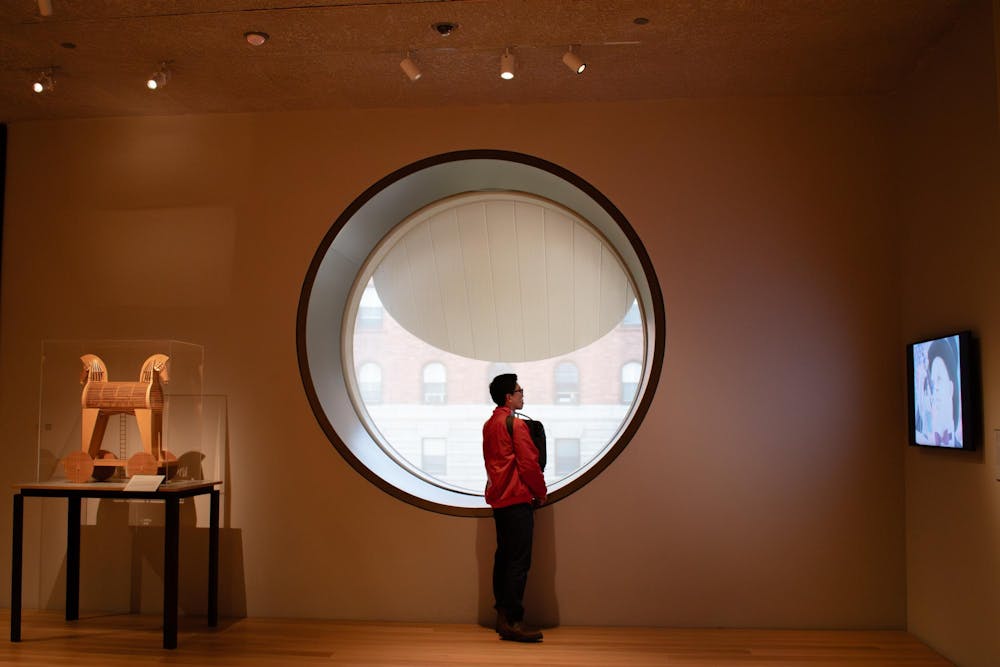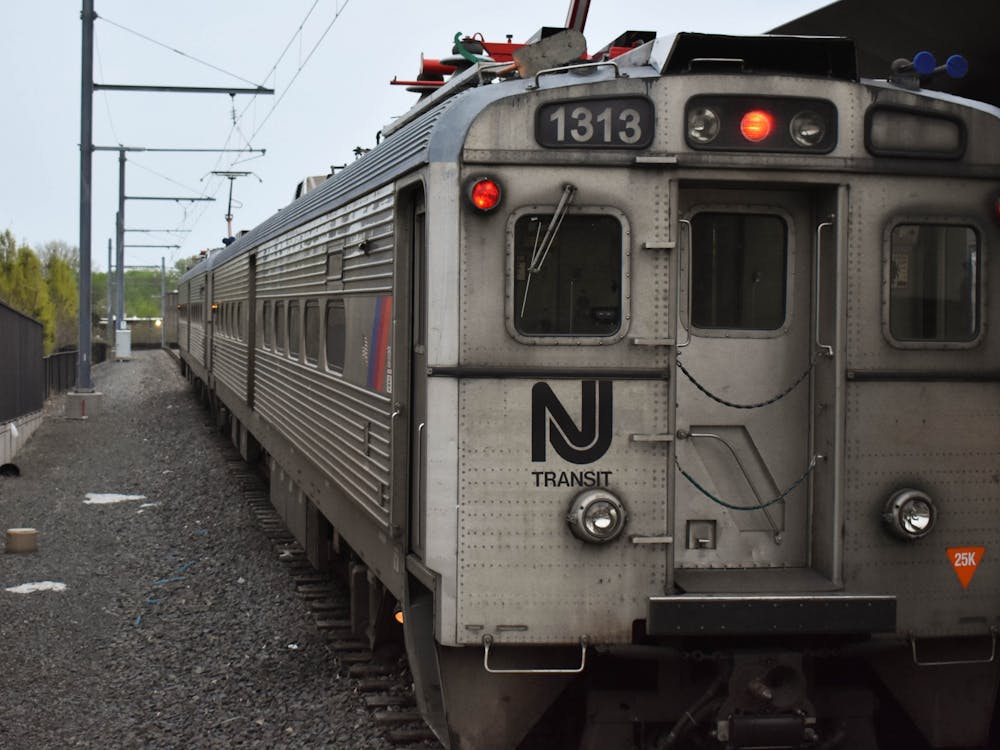The following is a guest contribution and reflects the authors’ views alone. For information on how to submit a piece to the Opinion section, click here.
When it opened on Friday, Oct. 31, the Princeton University Art Museum became one of the largest collegiate museums in the United States, enclosing an astounding 146,000 square feet. On architectural and curatorial terms, however, the use of that massive space is far from optimal.
We find a few areas to be responsible for the disparity between actual and apparent square footage at the museum. Architecturally, the first floor is full of disappointing redundancies. On the second floor, the distribution of galleries exposes a number of oversights in the curatorial program, relegating art produced in the global south to corridors and “in-between” spaces. The nail in the coffin? None of it is labeled.
The Grand Hall is an architectural feat, providing a triple-height “town square” for the museum. However, the double-height atrium directly next to it (with an embedded mosaic underneath) fulfills the same role, only it is grossly overshadowed by its competitor. To be triply certain, there is a third reception area: the vast foyer surrounding the oversized Grand Stair. These redundancies add up, guzzling thousands of square feet of interior space. While most museums are plagued by a lack of square footage, ours is spoiled for it, but sets aside cavernous areas for occasional use.

A double-height atrium directly beside the museum’s Grand Hall.
Katharine Shea / The Daily Princetonian
At the same time, crucial functions are squeezed for space. Just two seminar rooms for the Department of Art and Archaeology are almost certain to fall short, even with six object study rooms, as all are shared with the museum. The auditorium seats just 70, and could have been built where the “amphitheater” (a lawn, really) presently stands. Plus, an auditorium of 150 would mitigate the problem of closing the Grand Hall for department lectures. Haskell Education Center, conceived with rich potential to combine department, library, and museum, ended up as a glorified hallway, with no substantive student commons.
Moving above the compromised allocation of educational space on the first floor, we see a gallery layout that is best described as contradictory. Art Museum Director James Steward has repeatedly claimed that consolidating the collections on one level “overcomes traditional hierarchies of display.” To set out for a non-hierarchical museum is a tantalizing fool’s errand — every museum, regardless of its spatial layout, is deeply hierarchical. Our museum’s intertwined histories with Princeton “expeditions” is a key example of our embedded colonial “hierarchies.” This is not to be cynical, but rather to say: Hierarchies cannot be escaped, and the present layout has plenty on display.
To give Steward his due, the promise of displaying most art on one level is fulfilled, but why would a vertical axis be the only means of articulating spatial superiority? As visitors roam through the primary exhibition level, they encounter clear demarcations between three tiers of regions: those thought to merit their own enclosed, sanctified “pavilions,” those given smaller, walled rooms, and finally, those cast helplessly into the fissures in between.

Regionally speaking, standalone pavilions are bestowed upon European Art, Asian Art, and American Art. These double-height bravura spaces are the “gold standard” in museum design — their opulent dimensions, solar-tubed and artificial diffused lighting, and deep jewel-tone palettes all testify to it. In fact, these pavilions may very well be among the best rooms to house art on any American university campus. If only three regional collections receive this treatment, though, what do the others get?

Embodying the height of museum grandeur, the European Pavilion sits on the northwest corner of the site.
Katharine Shea / The Daily Princetonian
The next rung consists of what we call “rooms.” These spaces are still remarkably designed, with the same eight-figure Studio Joseph casework and exceptional object lighting found elsewhere. Operating on a diminished scale, however, these rooms are closer to human height, and are about two-thirds the square footage of a standalone pavilion. The museum calls these rooms “pavilions,” too, but architecturally, a “pavilion” is a detached volume. Ancient Mediterranean Art and Art of the Ancient Americas, simply walled spaces, are rooms.

Illustration of how geographic galleries are allocated on the second floor, showcasing three “tiers” of display.
Courtesy of Robert Mohan, based on publicly available site plans

The lowest rung exposes the most spatially literalized concepts of inferiority on the site. This tier includes the cultures without any demarcated place at all: South Asia, Latin America, the Islamic World, and Africa. These geographies — unapologetically cast out from the grandeur of the pavilions, and not deemed worthy of a walled room — sit instead in the hallways.
South Asia occupies a space scarcely six feet wide, crammed between an interior wall and the glass of that surplus atrium. Latin America is quite literally a corner outside the American pavilion. Africa is given the most disheartening treatment among these, occupying the unorganized space at the end of an arterial corridor. African objects float in this afterthought of a gallery space, estranged from any spatial anchor. It is not a destination to linger in, but a transit zone between other regions. Princeton’s over eight hundred pieces of African art (most in storage, with a precious few in this hallway) deserve better.

The unlabeled hallway for African Art at the museum.
Katharine Shea / The Daily Princetonian
While the gallery titles on the museum’s map reflect regionality, the physical signage in the museum conveys only the names of donors. This hands-off approach to wayfinding is baffling for a museum of this size. With so many galleries, some at intersections and in hallways, wall text is crucial to loudly introduce each space. Without it, cultures are not only spatially disenfranchised, but outright disappear.
Thankfully, the utter lack of signage could be remedied. First, regional nomenclature could be added outside each gallery. Without it, the museum precludes the viewer from an intentional approach. Secondly, ample wall space exists near the entrances of each gallery, an ideal place to add orienting text.

Empty floor space abounds in the Ancient Americas collection. To the left, a wall left bare for nonexistent introductory text.
Courtesy of Robert Mohan
These blank, nondescript walls give the museum a deserted feel. Larger works of art are swallowed by even larger sections of bare walls, as if the space was decorated, rather than curated. In other instances, works are hidden in drawers or crammed haplessly into vitrines surrounding the Grand Hall. The result is an erratic visual rhythm — blank expanses beside crowded displays. Despite more displayed art and a tripled floor area, the galleries toggle between underfilled and cluttered.
Yet the museum’s curators are quick to assure that these choices are radical strategies for promoting intellectual cross-pollination. In a recent interview, Steward held that a more undefined, unlabeled program would “bring out ideas of cultural exchange and encounter across geographies and chronologies.” We aren’t convinced.
If we assume an intuitive geographic flow, what could justify the movement from South Asian into Native North American and Alaskan Art? The indiscernible calculus of this arrangement, combined with the total lack of signage, impoverishes the regions relegated to hallways. They become a collective “other,” the filler-space between civilizations.
The denial of demarcated space for specific geographies is hardly a transgressive act. When we look at the scattered display of African Art across its corridor, and then compare it with the lavish, commanding pavilion that houses European Art, we cannot help but ask: Why does one continent deserve permanence in this museum? Why does one continent deserve that special kind of “slowness” which only a closed, walled space can provide? The answer is an unfortunate one: Africa and its peers serve purely a didactic purpose, as counterpoints to the favored geographies of Europe and America. That is what the spatial program proclaims.
Even if the hallways had the same square footage as the pavilions, these cannot realistically be held as equal to the pavilions to which they lead. The construction of walls around African, Islamic, and Latin American Art would add a meaningful sense of place and spatial permanence to these collection areas. Enclosure should not terrify the curator. It should be recognized as an empowering, enunciatory act.
To be sure, Princeton’s new art museum is an outstanding work of architecture. Its centrality on campus is commendable, and its neobrutalist façade is compelling. However, our shared optimism for this project makes us all the more attuned to its overt missteps. It’s one thing to build a museum. It’s another to fill it.
Robert Mohan is a senior from Phoenix studying Art & Archaeology (History of Art). He can be reached at robert.mohan[at]princeton.edu.
Madison Anderson is a junior from Rochester, N.Y. studying Art & Archaeology (History of Art), and is a former Cartoonist for the ‘Prince.’ She can be reached at ma6148[at]princeton.edu.
Please send any corrections to corrections[at]dailyprincetonian.com.








